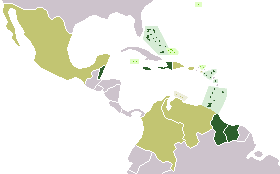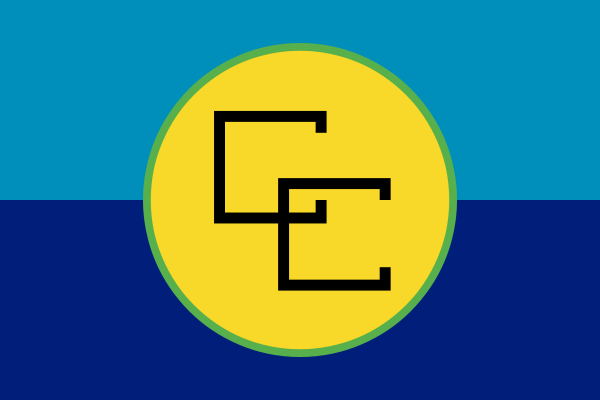Caribbean Community
 |  |
Name: Caribbean Community | |
| Acronym: Caricom | |
| Year of foundation: 1973 | |
| Headquarters: Georgetown, Guyana | |
| Official web site: go to page | |
| Caribbean Community documents: go to page | |
Description
The Caribbean Community (CARICOM) is a regional organization of 15 Caribbean countries and dependencies, whose main objectives are the promotion of economic integration, the cooperation among its member States, the assurance that the benefits of integration are equitably shared, and the coordination of foreign policy.
Member States
CARICOM has 15 full members, 5 associate members, and 7 observers:
DATE | COUNTRY | STAUS | NOTES |
1 August 1973 | Barbados | Full members |
|
1 May 1974 | Belize | Full members | Montserrat is a territory of the United Kingdom |
4 July 1974 | Antigua and Barbuda | Full member |
|
26 July 1974 | St. Kitts and Nevis | Full member | Joined as Saint Christopher-Nevis-Anguilla |
4 July 1983 | The Bahamas | Full member | Not part of customs union |
4 July 1995 | Suriname | Full member |
|
2 July 2002 | Haiti | Full member | Provisional membership on 4 July 1998 |
|
|
|
|
2 July 1991 | British Virgin Islands | Associate members | British overseas territories |
4 July 1999 | Anguilla | Associate member | British overseas territory |
15 May 2002 | Cayman Islands | Associate member | British overseas territory |
2 July 2003 | Bermuda | Associate member | British overseas territory |
|
|
|
|
| Aruba | Observers |
|
Brief History
In 1972, Commonwealth Caribbean leaders of Barbados, Jamaica, Guyana and Trinidad and Tobago at the Seventh Heads of Government Conference decided to transform the Caribbean Free Trade Association (CARIFTA) into a Common Market and established the Caribbean Community, of which the Common Market would be an integral part.
On 4th July 1973 the Treaty establishing the Caribbean Community, called the Treaty of Chaguaramas, was signed by the four countries. It had been a defining moment in the history of the Commonwealth Caribbean: although a free-trade area had been established, CARIFTA did not provide for the free movement of labor and capital, or the coordination of agricultural, industrial and foreign policies.
In 1989, when the Heads of Government made the decision to transform the Common Market into a single market and economy in which factors move freely as a basis for internationally competitive production of goods and provision of services, it was also decided that for the transformation to take place, the Treaty would have to be revised.
The Revised Treaty of Chaguaramas establishing the Caribbean Community including the CARICOM Single Market and Economy (CSME) was signed by the CARICOM Heads of Government of the Caribbean Community on 5 July 2001 at their Twenty-Second Meeting of the Conference in Nassau, The Bahamas.
CARICOM Structure and Decision-making Procedures
According to the Revised Treaty of Chaguaramas, CARICOM principal organs are the Conference of Heads of Government (and its Bureau) and the Community Council of Ministers (The Community Council).
They are assisted by the CARICOM Secretariat - the Principal Administrative Organ, by five organs (the Council for Finance and Planning - COFAP; the Council for Trade and Economic Development - COTED; the Council for Foreign and Community Relations - COFCOR; the Council for Human and Social Development - COHSOD; The Council of Ministers responsible for National Security and Law Enforcement), and by three bodies:
- the Legal Affairs Committee, which provides legal advice to the organs and bodies of the Community;
- the Budget Committee, which examines the draft budget and work programme of the Secretariat and submits recommendations to the Community Council;
- and, the Committee of Central Bank Governors, which provides recommendations to the COFAP on monetary and financial matters.
The post of Chairman (Head of CARICOM) is held in rotation by the regional Heads of State (for the republics) and Heads of Government (for the realms) of CARICOM’s 15 member states.
CARICOM Conference of Heads of Governments
CARICOM contains a quasi-Cabinet of the individual Heads of Government. These heads are given specific specialized portfolios of responsibility for overall regional development and integration.
The Conference of Heads of Government consists of the Heads of Government of the Member States. Any Head of Government may designate a Minister or other person to represent him or her at any Meeting of the Conference.
The Conference is the supreme Organ of the Community and determines and provides policy direction for the Community.
Except where otherwise provided in the Revised Treaty of Chaguaramas establishing the Caribbean Community including the CARICOM Single Market and Economy, the Conference is the final authority for the conclusion of treaties on behalf of the Community and for entering into relationships between the Community and international organizations and States.
The Conference may take decisions in order to establish the financial arrangements necessary to defray the expenses of the Community and is the final authority on questions arising in relation to the financial affairs of the Community.
The Community Council
The Community Council consists of Ministers responsible for Community Affairs and any other Minister designated by the Member States in their absolute discretion.
In accordance with the policy directions established by the Conference, the Community Council has primary responsibility for the development of Community strategic planning and co-ordination in the areas of economic integration, functional co-operation and external relations.
The Community Council approves the programmes of the Community on the basis, inter alia, of proposals emanating from other Community Organs and amends proposals developed by the Ministerial Councils or requests them to develop proposals for the achievement of Community objectives, and has responsibility for promoting and monitoring the implementation of Community decisions in the Member States.
CARICOM Secretariat
CARICOM Secretariat is the chief administrative organ. The term of office of the Secretary-General is 5 years, which may be renewed. It handles Foreign and Community Relations and provides dynamic leadership and service, in partnership with Community institutions and Groups, toward the attainment of a viable, internationally competitive and sustainable Community, with improved quality of life for all.
